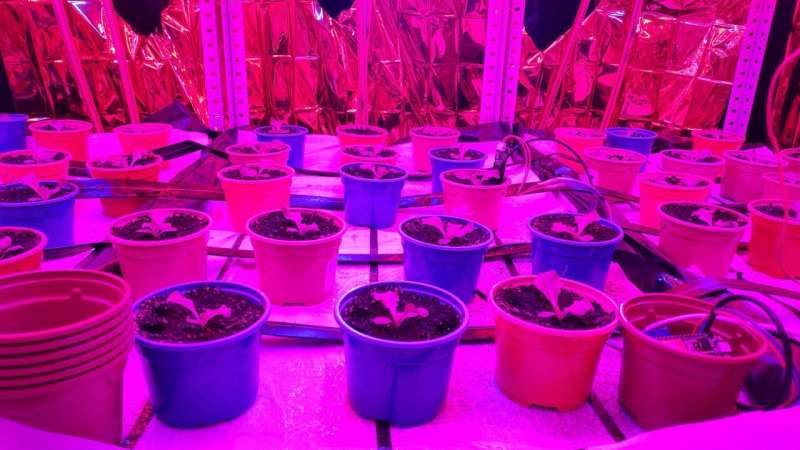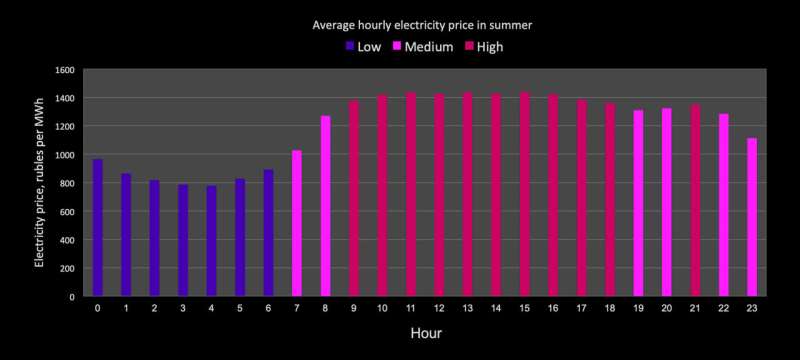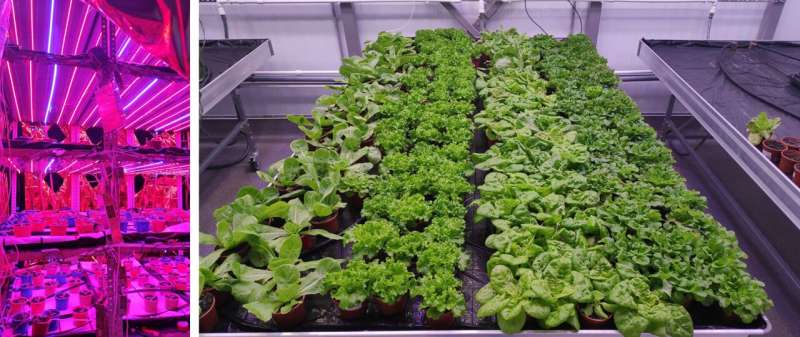This article has been reviewed according to Science X's editorial process and policies. Editors have highlighted the following attributes while ensuring the content's credibility:
fact-checked
trusted source
proofread
Leafy greens grown by night prove cheaper and just as good

Utility companies offer flexible electricity rates depending on the time of day to reduce demand at peak hours. That way, consumers can save some money, say, by using the dishwasher or tumble dryer at night. And the utilities avoid the need for massive investment into power plants to keep up with peak demand.
Now, if this works with your laundry, there is no reason it should not work with indoor agriculture and make leafy greens cheaper, too. If you grow lettuce at night, it is still the same lettuce, right? Skoltech researchers decided to find out by running a monthlong experiment in model greenhouses and vertical farms called phytotrons.
Their paper in Applied Energy concludes that by tinkering with the artificial lighting schedule, it is possible to reduce the associated electricity bills by almost a quarter. And the lettuce is fine.
The climate in many countries makes greenhouses the ultimate mode of vegetable farming, not just for temperature reasons, but also because there is not enough natural light. So if farmers rely on electric lights anyway, why not switch them on during the utility's happy hours?
The indoor microclimate control system in greenhouses or vertical farms could then switch off the lights during the more expensive hours, because vegetables require nighttime for healthy growth in any case. But unlike a washing machine, a plant is a living, growing organism, and we need to make sure that substituting a continuous night with multiple shorter periods of darkness will not interfere with the growth.
"We ran an experiment growing different varieties of lettuce and endive (also known as chicory) in two identical greenhouses under the same conditions with the exception of the lighting regimen," said the study's lead author Javier Peñuela, a Ph.D. student of engineering systems at Skoltech.
"Both groups of plants received 16 hours of light daily at the recommended intensity. However, in the control group the dark hours were lumped together to roughly coincide with the natural night. Whereas in the test group the dark hours were scattered throughout the day based on when electricity was at its most expensive. This did not measurably affect plant growth in any of the varieties."
"We believe this result could be extended to basil, spinach, and other green leafy vegetables, as in our experiments we accounted for genetic diversity to test for possible negative effects on the growth rates," added Associate Professor Cécile Ben of Skoltech Agro, who co-authored the study.

The researchers also carried out a similar experiment on just lettuce in a four-storied vertical farm, with the same result. Namely, once the test period was over, the team compared the crops in the test group against the control group by counting the number of leaves and measuring the plants' weight—both freshly harvested and dried. No significant differences were observed.
As for the cost-saving potential, calculations reported in the study show the expenses for artificial lighting can be cut by between 15% and 23%, depending on which mode of compensation by the electric utility is engaged. The lower of the two values corresponds to so-called price-based demand response, and the higher value results from adding contract-based demand response on top of that.
The former means taking advantage of hourly electricity rates, and the latter involves an explicit longer-term contract where the farm commits to putting out the lights for a certain amount of time upon request of the utility. For the Russian grid it would yield savings of up to $110 million per year.
Ultimately, lowering the cost of producing vegetables can dampen price growth.

"At its core, our work deals with the unexploited potential synergies between the food industry and the energy system in an urban environment," study co-author Professor Laurent Gentzbittel of Skoltech Agro commented.
"Such synergies are made possible by the digitalization and decarbonization of the energy system," said Engineering Center Associate Professor Henni Ouerdane, the principal investigator of the study.
"This transformation is a costly endeavor, which does, however, create many opportunities for increasing the efficiency of the generating capacity, bringing down the cost of operation and expansion of the energy system. Demand-side flexibility enables much of those cost-reduction benefits to be allocated to industries such as indoor agriculture, which create that flexibility, transforming their energy-hungriness from a liability to an opportunity."
According to the researchers, the economic advantage they have demonstrated may prove partially transferable to tomatoes, cucumbers, and—to a lesser extent—to strawberries. Because these plants flower and bear fruit, they undergo additional stages of development for more than half of their life, during which the findings from the leafy greens study may not apply.
For some varieties, lighting conditions are critical at and after inflorescence appearance. Developing photo-insensitive day-neutral varieties that will flower regardless of day length may allow benefiting from cost-saving energy-demand flexibility for indoor agriculture for those crops as well.
Besides encompassing more plant varieties, the study could expand by considering ways to economize on heating expenses, too. The members of the team behind the study see demand response as the future of the power industry.
While massive arrays of accumulators, such as the vanadium redox flow batteries developed at Skoltech, will no doubt play a part in evening out the load on the network, demand response strategies of ever-greater sophistication will contribute to the same goal without any massive hardware involved—keeping the network in balance purely by virtue of market forces.
More information: Javier Penuela et al, The indoor agriculture industry: A promising player in demand response services, Applied Energy (2024). DOI: 10.1016/j.apenergy.2024.123756
Provided by Skolkovo Institute of Science and Technology




















